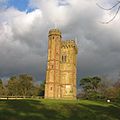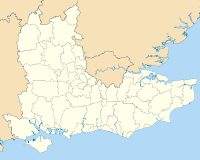The South East England Portal

South East England is one of the nine official regions of England in the United Kingdom at the first level of ITL for statistical purposes. It consists of the nine counties of Berkshire, Buckinghamshire, East Sussex, Hampshire, the Isle of Wight, Kent, Oxfordshire, Surrey and West Sussex. Cities and towns in the region include Aldershot, Ashford, Aylesbury, Basingstoke, Bracknell, Brighton and Hove, Canterbury, Chichester, Crawley, Eastbourne, Farnborough, Gosport, Guildford, Hastings, High Wycombe, Margate, Maidstone, Medway, Milton Keynes, Newport, Oxford, Portsmouth, Ramsgate, Reading, Slough, Southampton, Winchester, Woking and Worthing.
South East England is the third-largest region of England, with a land area of 19,072 square kilometres (7,364 sq mi), and is also the most populous with a total population of 9,379,833 in 2022. The region contains eight legally chartered cities: Brighton and Hove, Canterbury, Chichester, Milton Keynes, Oxford, Portsmouth, Southampton and Winchester. The region's close proximity to London has led to South East England becoming a prosperous economic hub with the largest economy of any region in the UK, after London. The region is home to Gatwick Airport, the UK's second-busiest airport, and Heathrow Airport (the UK's busiest airport) is located adjacent to the region's boundary with Greater London. The coastline along the English Channel provides numerous ferry crossings to mainland Europe.
The region is known for its countryside, which includes two national parks: the New Forest and the South Downs, as well as the North Downs, the Chiltern Hills and part of the Cotswolds. The River Thames flows through the region and its basin is known as the Thames Valley. It is also the location of a number of internationally known places of interest, such as HMS Victory in Portsmouth, Cliveden in Buckinghamshire, Thorpe Park and RHS Wisley in Surrey, Blenheim Palace in Oxfordshire, Windsor Castle in Berkshire, Leeds Castle, the White Cliffs of Dover and Canterbury Cathedral in Kent, Brighton Palace Pier, and Hammerwood Park in East Sussex, and Wakehurst Place in West Sussex. The region has many universities; the University of Oxford is the oldest in the English-speaking world, and ranked among the best in the world.
South East England is host to various sporting events, including the annual Henley Royal Regatta, Royal Ascot and The Derby, and sporting venues include Wentworth Golf Club and Brands Hatch. Some of the events of the 2012 Summer Olympics were held in the south east, including the rowing at Eton Dorney and part of the cycling road race in the Surrey Hills.
In medieval times, South East England included much of the Kingdom of Wessex, which was the precursor to the modern state of England. Winchester was the capital of England after unification of the various states, including the kingdoms of Kent, Sussex and Mercia. Winchester stopped being the administrative capital of England some time in the 13th century as its influence waned while the City of London dominated commerce. The last monarch to be crowned at Winchester was Richard II in 1377, although the last monarch to be crowned by the Bishop of Winchester was Queen Mary I in 1553. (Full article...)
Selected article
The River Rother flows from Empshott in Hampshire, England, to Stopham in West Sussex, where it joins the River Arun. At 52 kilometres (32 mi) long, most of the river lies within West Sussex except for the first 10 kilometres (6.2 mi) which lie in Hampshire. The upper river, from its source to Midhurst, has been used to power watermills, with the earliest recorded use being in 1086, when the Domesday survey was conducted. Although none are still operational, many of the buildings which housed the mills still exist, and in some cases, still retain their milling machinery. This upper section is also noted for a number of early bridges, which have survived since their construction in the fifteenth, sixteenth and seventeenth centuries.
The lower river, from Midhurst to its junction with the River Arun, has been used for navigation. Boats used the section from the Arun to Fittleworth following improvements made to the Arun in 1615, and after the Arun Navigation was completed in 1790, the Earl of Egremont made the river navigable up to Midhurst by constructing eight locks and some small cuts. The work was completed in 1794, and many of the bridges built at that time still survive. With the opening of the Mid-Sussex Railway branch to Midhurst in 1859, traffic declined, and commercial use of the river had ceased by the 1880s. Pleasure boats continued to be used on the river for many years, and published accounts of journeys along the decaying navigation appeared in 1914 and 1920. The navigation was officially abandoned in 1936, after an undergraduate pointed out that it was still a public right of way.
The river flows through the South Downs National Park, and is a designated Site of Nature Conservation Importance, in recognition of its value for wildlife. It supports a wide range of fish, and its upper reaches are the only location in Sussex where native white clawed crayfish can be found. The quality of the water is generally good, and the river is measured at four gauging stations, three on the main channel, and one of the River Lod, just before its junction with the Rother. Water from the underlying Lower Greensand aquifer and the adjacent chalk aquifer helps to maintain the flows during the summer months, despite the fact that large volumes are abstracted from both the aquifers and the river for the public water supply. (Full article...)
Selected pictures
Selected biography
Rodney Stephen Hull (13 August 1935 – 17 March 1999) was a British comedian and popular entertainer on television in the 1970s and 1980s. He rarely appeared without Emu, a mute and highly aggressive arm-length puppet modelled on the Australian bird. (Full article...)
On This Day in South East England
10 November:
- 1850: Composer Arthur Goring Thomas was born in Ratton Park in Sussex
- 1944: Lyricist Sir Tim Rice was born in Amersham, Buckinghamshire
Categories
Related portals
WikiProjects
Topics
Associated Wikimedia
The following Wikimedia Foundation sister projects provide more on this subject:
-
Commons
Free media repository -
Wikibooks
Free textbooks and manuals -
Wikidata
Free knowledge base -
Wikinews
Free-content news -
Wikiquote
Collection of quotations -
Wikisource
Free-content library -
Wikiversity
Free learning tools -
Wikivoyage
Free travel guide -
Wiktionary
Dictionary and thesaurus































































































































